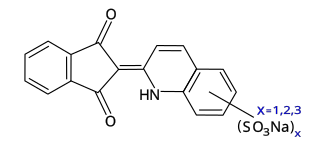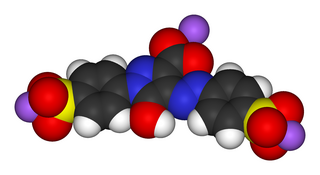Related Research Articles

Aspartame is an artificial non-saccharide sweetener 200 times sweeter than sucrose and is commonly used as a sugar substitute in foods and beverages. It is a methyl ester of the aspartic acid/phenylalanine dipeptide with brand names NutraSweet, Equal, and Canderel. Aspartame was approved by the US Food and Drug Administration (FDA) in 1974, and then again in 1981, after approval was revoked in 1980.

Attention deficit hyperactivity disorder (ADHD) is a neurodevelopmental disorder characterised by excessive amounts of inattention, hyperactivity, and impulsivity that are pervasive, impairing in multiple contexts, and otherwise age-inappropriate.

Food coloring, or color additive, is any dye, pigment, or substance that imparts color when it is added to food or drink. They be supplied as liquids, powders, gels, or pastes. Food coloring is used in both commercial food production and domestic cooking. Food colorants are also used in a variety of non-food applications, including cosmetics, pharmaceuticals, home craft projects, and medical devices. Colorings may be natural or artificial/synthetic.

Quinoline Yellow WS is a mixture of organic compounds derived from the dye Quinoline Yellow SS. Owing to the presence of sulfonate groups, the WS dyes are water-soluble (WS). It is a mixture of disulfonates (principally), monosulfonates and trisulfonates of 2-(2-quinolyl)indan-1,3-dione with a maximum absorption wavelength of 416 nm.p. 119

Reye syndrome is a rapidly worsening brain disease. Symptoms of Reye syndrome may include vomiting, personality changes, confusion, seizures, and loss of consciousness. While liver toxicity typically occurs in the syndrome, jaundice usually does not. Death occurs in 20–40% of those affected with Reye syndrome, and about a third of those who survive are left with a significant degree of brain damage.

Tartrazine is a synthetic lemon yellow azo dye primarily used as a food coloring. It is also known as E number E102, C.I. 19140, FD&C Yellow 5, Yellow 5 Lake, Acid Yellow 23, Food Yellow 4, and trisodium 1-(4-sulfonatophenyl)-4-(4-sulfonatophenylazo)-5-pyrazolone-3-carboxylate).

Sunset yellow FCF is a petroleum-derived orange azo dye with a pH dependent maximum absorption at about 480 nm at pH 1 and 443 nm at pH 13 with a shoulder at 500 nm. When added to foods sold in the United States it is known as FD&C Yellow 6; when sold in Europe, it is denoted by E Number E110.
Food intolerance is a detrimental reaction, often delayed, to a food, beverage, food additive, or compound found in foods that produces symptoms in one or more body organs and systems, but generally refers to reactions other than food allergy. Food hypersensitivity is used to refer broadly to both food intolerances and food allergies.

Aspirin-exacerbated respiratory disease (AERD), also called NSAID-exacerbated respiratory disease (NERD/N-ERD) or historically aspirin-induced asthma and Samter's Triad, refers to the triad of asthma, chronic rhinosinusitis with nasal polyps, and intolerance of aspirin and other nonsteroidal anti-inflammatory drugs (NSAIDs). AERD most commonly begins in early- to mid-adulthood and is a chronic disease that has no known cure. The cause of the disease is a dysregulation of the arachidonic acid metabolic pathway and of various innate immune cells, though the initial cause of this dysregulation is not currently known. While NSAID intolerance is a defining feature of AERD, simple avoidance does not prevent the onset, development or perennial nature of the disease.
Adult attention deficit hyperactivity disorder is the neurological condition of attention deficit hyperactivity disorder (ADHD) in adults. About one-third to two-thirds of children with symptoms from early childhood continue to demonstrate ADHD symptoms throughout life.

Erythrosine, also known as Red No. 3, is an organoiodine compound, specifically a derivative of fluorone. It is a pink dye which is primarily used for food coloring. It is the disodium salt of 2,4,5,7-tetraiodofluorescein. Its maximum absorbance is at 530 nm in an aqueous solution, and it is subject to photodegradation.

Ponceau 4R is a synthetic colourant that may be used as a food colouring. It is denoted by E Number E124. Its chemical name is 1-(4-sulfo-1-napthylazo)-2-napthol-6,8-disulfonic acid, trisodium salt. Ponceau is the generic name for a family of azo dyes.
Benjamin F. Feingold was a pediatric allergist from California who proposed in 1973 that salicylates, artificial colors, and artificial flavors cause hyperactivity in children. Hyperactivity is now classified as Attention deficit hyperactivity disorder (ADHD).

Allura Red AC is a red azo dye that goes by several names, including FD&C Red 40. It is used as a food dye and has the E number E129.

Azorubine is an azo dye consisting of two naphthalene subunits. It is a red solid. It is mainly used in foods that are heat-treated after fermentation. It has E number E122.

Salicylate sensitivity is any adverse effect that occurs when a usual amount of salicylate is ingested. People with salicylate intolerance are unable to consume a normal amount of salicylate without adverse effects.
Attention deficit hyperactivity disorder management options are evidence-based practices with established treatment efficacy for ADHD.
Alternative therapies for developmental and learning disabilities include a range of practices used in the treatment of dyslexia, ADHD, autism spectrum disorders, Down syndrome and other developmental and learning disabilities. Treatments include changes in diet, dietary supplements, biofeedback, chelation therapy, homeopathy, massage and yoga. These therapies generally rely on theories that have little scientific basis, lacking well-controlled, large, randomized trials to demonstrate safety and efficacy; small trials that have reported beneficial effects can be generally explained by the ordinary waxing and waning of the underlying conditions.
An elimination diet, also known as exclusion diet, is a diagnostic procedure used to identify foods that an individual cannot consume without adverse effects. Adverse effects may be due to food allergy, food intolerance, other physiological mechanisms, or a combination of these. Elimination diets typically involve entirely removing a suspected food from the diet for a period of time from two weeks to two months, and waiting to determine whether symptoms resolve during that time period. In rare cases, a health professional may wish to use an elimination diet, also referred to as an oligoantigenic diet, to relieve a patient of symptoms they are experiencing.

Metadoxine, also known as pyridoxine-pyrrolidone carboxylate, is a drug used to treat chronic and acute alcohol intoxication. Metadoxine accelerates alcohol clearance from the blood.
References
- ↑ Turka LA, Caplan A (July 2011). "What is the evidence for our standards of care?". J. Clin. Invest. 121 (7): 2530. doi:10.1172/JCI59185. PMC 3127439 . PMID 21737884.
- 1 2 Kavale KA, Forness SR (1983). "Hyperactivity and Diet Treatment: A Meta-Analysis of the Feingold Hypothesis". Journal of Learning Disabilities. 16 (6): 324–30. doi:10.1177/002221948301600604. ISSN 0022-2194. PMID 6886553. S2CID 41744679.
- 1 2 3 "Eating well and mental health". Royal College of Psychiatrists. January 2014.
- 1 2 3 Barrett S (March 11, 2002). "The Feingold Diet". Quackwatch. Retrieved 15 April 2021.
- 1 2 3 4 5 6 Smith, Matthew (2011). An alternative history of hyperactivity: Food additives and the' Feingold Diet. Rutgers University Press. ISBN 978-0813550169.
- ↑ Stevens LJ, Kuczek T, Burgess JR, Hurt E, Arnold LE (April 2011). "Dietary Sensitivities and ADHD Symptoms: Thirty-five Years of Research". Clinical Pediatrics. 50 (4): 279–93. doi:10.1177/0009922810384728. PMID 21127082. S2CID 17503227.
- 1 2 Kanarek RB (July 2011). "Artificial food dyes and attention deficit hyperactivity disorder". Nutr. Rev. 69 (7): 385–91. doi: 10.1111/j.1753-4887.2011.00385.x . PMID 21729092.
- ↑ Tomaska LD and Brooke-Taylor, S. Food Additives – General pp. 449–54 in Encyclopedia of Food Safety, Vol 2: Hazards and Diseases. Eds, Motarjemi Y et al. Academic Press, 2013. p. 452. ISBN 978-0123786135
- ↑ Millichap JG, Yee MM (February 2012). "The diet factor in attention-deficit/hyperactivity disorder". Pediatrics. 129 (2): 330–37. doi:10.1542/peds.2011-2199. PMID 22232312. S2CID 14925322.
- ↑ FDA. Background Document for the Food Advisory Committee: Certified Color Additives in Food and Possible Association with Attention Deficit Hyperactivity Disorder in Children: March 30–31, 2011
- ↑ "Scientific Opinion on the re-evaluation of Sunset Yellow FCF (E 110) as a food additive". EFSA Journal. 7 (11): 1330. 2009. doi: 10.2903/j.efsa.2009.1330 .
- ↑ Dumbrell, S.; Woodhill, J.M.; Mackie, L. & Leelarthaepin, B. (December 1978). "Is the Australian version of the Feingold diet safe?". The Medical Journal of Australia. 2 (12): 569–70. doi:10.5694/j.1326-5377.1978.tb131717.x. PMID 364258. S2CID 34426994.
- ↑ Feingold, B.F. (1975). Why Your Child is Hyperactive . Random House. ISBN 0-394-73426-2.
- ↑ Bourne, A (1982). "Obituary: Ben F. Feingold, MD" (PDF). Ecology of Disease. 1 (2/3): 199.
- ↑ Feingold, B.F. (1973). Introduction to clinical allergy. Charles C. Thomas. p. 157. ISBN 0-398-02797-8.
- ↑ Settipane GA, Pudupakkam RK. (1975). "Aspirin intolerance. III. Subtypes, familial occurrence, and cross-reactivity with tartarazine". Journal of Allergy and Clinical Immunology. 56 (3): 215–21. doi:10.1016/0091-6749(75)90092-5. PMID 1151014.
- ↑ Lockey, SD (September–October 1959). "Allergic reactions due to F D and C Yellow No. 5, tartrazine, an aniline dye used as a coloring and identifying agent in various steroids". Annals of Allergy. 17: 719–21. PMID 14417794.
- ↑ Lockey, SD Sr. (1977). "Hypersensitivity to tartrazine (FD&C Yellow No. 5) and other dyes and additives present in foods and pharmaceutical products". Annals of Allergy. 38 (3): 206–10. PMID 842907.
- ↑ J.G. Beall, Jr. (October 30, 1973). "Food Additives and Hyperactivity in Children" (PDF). Congressional Record - Senate: 35401–07.
- ↑ Feingold, Ben F. (1982). "The Role of Diet in Behaviour" (PDF). Ecology of Disease. 2 (2/3): 153–65. PMID 6090095.
- ↑ [ non-primary source needed ]Conners CK, Goyette CH, Southwick DA, Lees JM, Andrulonis PA (August 1976). "Food additives and hyperkinesis: a controlled double-blind experiment". Pediatrics. 58 (2): 154–66. PMID 781610.